#how to grow an indoor garden
Explore tagged Tumblr posts
Text
How to Grow an Indoor Garden - For Beginners
Please like and share for more tips and hacks.
*Disclosure: This blog post contains affiliate links, meaning I get a commission or credit if you decide to make a purchase through my links at no cost to you. An Indoor Garden Hydroponic Growing System is a great way to grow your own vegetables, herbs and plants. It is especially great for people like me who try to garden the traditional way, but completely stink at it. I discovered this…

View On WordPress
#gardening for people who suck at it#gardening hacks#gardening ideas#Gardening tips and tricks#Gardening tips for beginners#gardening tips hacks#home remedies#how to grow an indoor garden#How to grow herbs and vegetables indoors#Hydroponic Gardening#Indoor Garden Hydroponic Growing System#Indoor gardening system#LED Grow Light#OnePathToTheWay#The Mandated Reporter#The Mandated Reporter Jr#The Work from Home Advisor
0 notes
Text
Cheaply Starting Seeds
This is my fourth post in a series I’ll be making on how to increase biodiversity on a budget! I’m not an expert--just an enthusiast--but I hope something you find here helps!
Having a high-quality seed-starting setup can feel like an ultimate but distant dream. An entire shelf--an entire room, even, filled with grow lights and plant trays in the optimal setup to make tons of plants? Tons of garden tools, each with a diverse and dedicated purpose? That’s just not an option for some of us. But that doesn’t mean we can’t get started at a low cost!
Seed Starting Set-Ups
Speaking from a somewhat biased Floridian perspective, I’ve had great success starting seeds outside! My usual set-up is on a rarely-used outdoor patio table that’s moved to a sunny spot in the yard, but I’ve even grown seeds in solo cups on sidewalks, or directly in the ground, with great results!

Some seeds grow best when they go through a cold period before germinating, while other seeds aren’t affected much by it and just wait for warm weather. As such, a viable option is to sow your seeds in late fall, let winter roll by, and wait until the seeds sprout on their own come spring! I would try and mark off where you planted said seeds, so you don’t lose track of them and accidentally dig them up.

Alternatively, if you want to get started while it's cold outside, a popular option I've seen is to grow in milk jugs! There's a lot of different ways to do it--everyone has their preference--but if you're already drinking things like milk or juice or sweet tea, and you're going to get jugs at some point in time--why not use them for gardening?
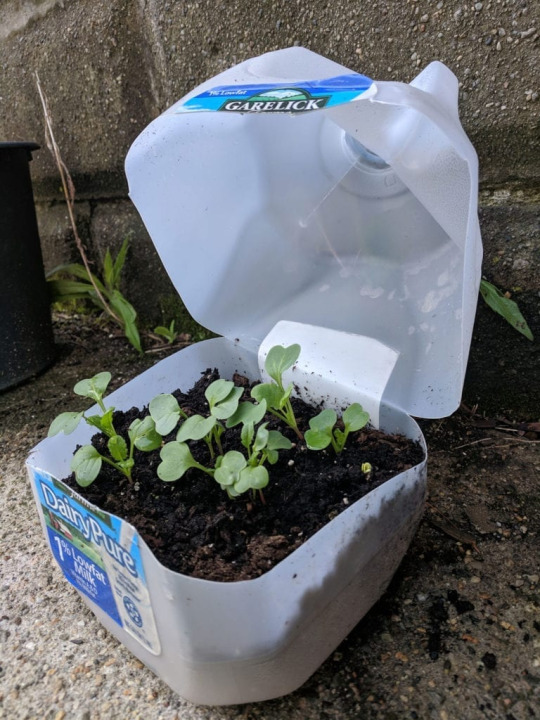
An easy way to clear up a section of lawn to create open gardening space is by using a sheet mulching or lasagna gardening method (though I like to call it the Cardboard Snuff-Out). Place cardboard or newspaper down in fall/winter to mark out where you want to garden. Layer compostable materials like grass clippings and wood chips on top of it, or potting soil/bagged compost. It’ll decompose over Winter into an organically rich bed that’ll have killed the grass and weeds underneath it. You don’t have to break out any tools and sweat over it come spring, and the cardboard itself will slowly decompose as well!

Though it's often recommended to plant things directly into the ground to decrease watering needs and increase nutritional independence, there’s plenty of reasons you may not be able to. Whether you’re renting, living in a place without a yard, or even just can’t or don’t want to break ground in a yard, you can still help biodiversity by growing in pots. Some plants have rather extensive root systems and aren’t well suited for pots, but there are still plenty of options available for plants that’ll boost biodiversity, be beautiful to look at, and grow just fine in pots! A recommendation is to get a larger pot, if you’re able, as it’ll hold onto more water and need watering less often. Not only are potted plants great for providing food for insects, but they can be shelter for other creatures too--there’s been a good few times I’ve moved a pot and found a frog or toad living underneath it.

If you don’t have room for pots on the ground, you could consider using hanging pots or window boxes! These can be great and easily-maintained options to provide food and habitat for insects and birds in an urban living situation like apartments or townhouses, but they can also be a fun way to add even more habitat to an already-robust home garden. You can even make an entire mini habitat in a window box or pot! I can personally say I’ve seen tons of pollinators visit my yearly hanging basket garden that consists of about five to seven plants, and I’ve always loved the idea of having a window box for blooms right out my window. Just make sure that it’s safe--make sure they’re securely fixed, and that whatever they’re hanging from can handle their weight when they’re freshly watered and loaded with plants.
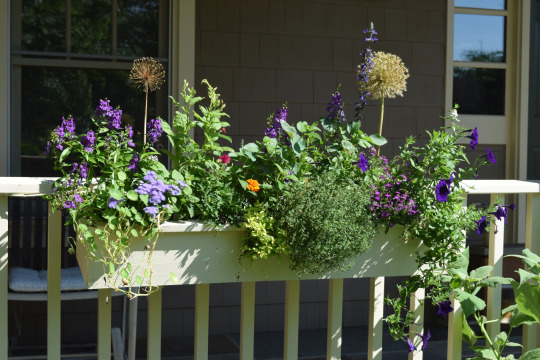
If you want to start indoors, you don’t necessarily need grow lights or heat mats (though it will make things a bit easier.) I’ve successfully grown milkweed, peppers, tomatoes, zucchinis, and even sprouted lemon seeds in college dorm rooms, and kept tomato and pepper plants in a dorm room on a sunny windowsill. For the most part, you need a nice and sunny window, some kind of container, and a source of heat (in my case, I used anything from a space heater to the warmth of my laptop running nearby. If you don’t have any sunny windows, or enough windowsill space to start plants on, its possible to obtain cheaper grow lights. One year, my mom bought me some gooseneck grow lights that could clip onto things for cheap off of Amazon. (Fair warning, though, they did light up my entire room in purple. I lived alone that year (covid year, my roomies bailed), so it was fine, but it was kind of trippy,)
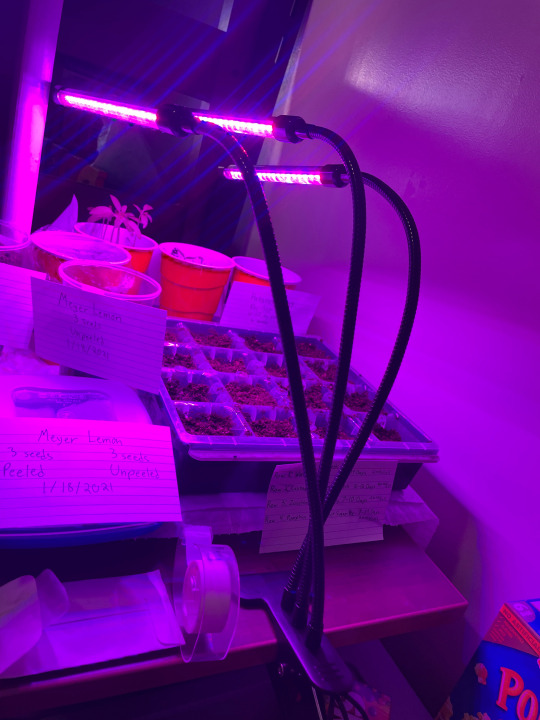
Another year, when I was in an apartment on my own, I bought a grow light modeled like a normal light bulb from the lightbulb aisle in Lowe’s and put it in my desk lamp. Growing seeds indoors can make them grow fast and leggy, so it’ll help if you can keep a desk fan on them so they focus on growing strong instead of tall and fast.
If you’re fortunate enough to have a friend with a nice set up, you could see if they’re willing to let you borrow some of their space to start your own plants as well! My set-up in college was by no means High Class, but I was still more than willing to start seeds for my friends who asked!
Containers for Seed Starting
So now that we’ve talked starting seeds indoors and out, we need to address what to start them in. It’s important that whatever you’re using has drainage holes, and be large enough to support your plant (starting something like milkweed or a squash in a tiny little pot won’t yield great results). Fortunately, there are options here!
If you’re looking to buy pots, Dollar Tree will sell some small plastic pots for cheap in the spring! They’re kind of thin, and won’t last forever, but they’re great for a few uses and don’t cost a lot of money. Something that’s a bit more pricey but are longer-lasting, in my experience, are the Burpee SuperSeed trays. They come in different sizes, but I’m fond of the 16-cell trays--they have silicone bottoms and are made of a nice solid plastic with a tray to hold water, so they hold up for a long time and are easy to clean and reuse!
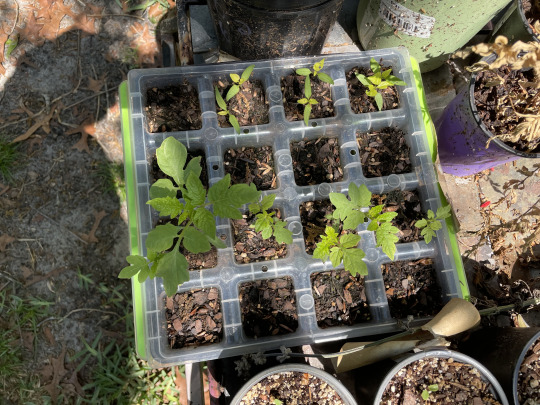
Burpee seed tray, my beloved.
What’s better than a cheap pot? Free ones, and there’s plenty of options there! I’ve seen people use toilet paper or paper towel rolls as pots by folding the bottoms in and have it work well for them! I think this method would work best if you had some kind of tray to keep them moist, because mine dried out fast last time I tried this method. I’ve also seen people make pots out of newspaper with a few different methods, and the people who use this method love it--apparently, the roots pass through the paper easier and it decomposes faster when buried, so you can just transplant the whole pot and avoid any kind of transplanting shock. If you don’t have any newspaper on hand, you can likely ask your friends or neighbors!

I’ve gotten lots of mileage from reusing old containers by poking a few holes in the bottom with knives or scissors--just be careful while you’re doing it! I, personally, am more likely to use an already-used solo cup for it--they’re a nice size, so they hold a good amount of soil and moisture and give the seedling a good amount of root space. I tend to write the plant information on the side of the cup in sharpie marker, or on an index card in pen. I’ve also heard of people making use of egg cartons, fruit containers, yogurt cups, milk cartons, soda bottles--the more you start thinking about what you could easily poke a hole in, the more options start coming around!
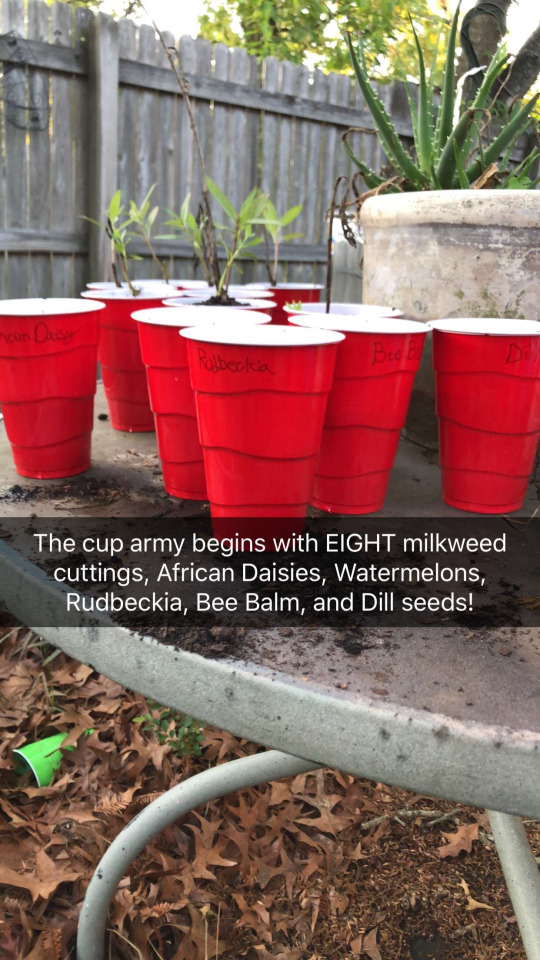
This photo may be from 2018, but I'll still regularly reuse cups like this! They're also great for cuttings!
As you start planning to move your seedlings into the ground and preparing planting sites, you’ll likely need a few tools to do it! How do you get these? You may be able to borrow some tools from a neighbor! As long as you make sure to return them in good condition, depending on how friendly your neighbors are, they might be totally fine with you borrowing their tools for awhile. If you don’t want to take that route, there may be a tool library you can borrow from, or a mutual aid group that can loan you tools for awhile. Either way, borrowing tools is cheaper than buying them--though, if you do have to buy tools, cheap hand-tools from Walmart or the dollar store work just fine. They’ll even last a good while if they’re taken care of when not in use! I've even seen places like Ross sell some tools and pots in spring!
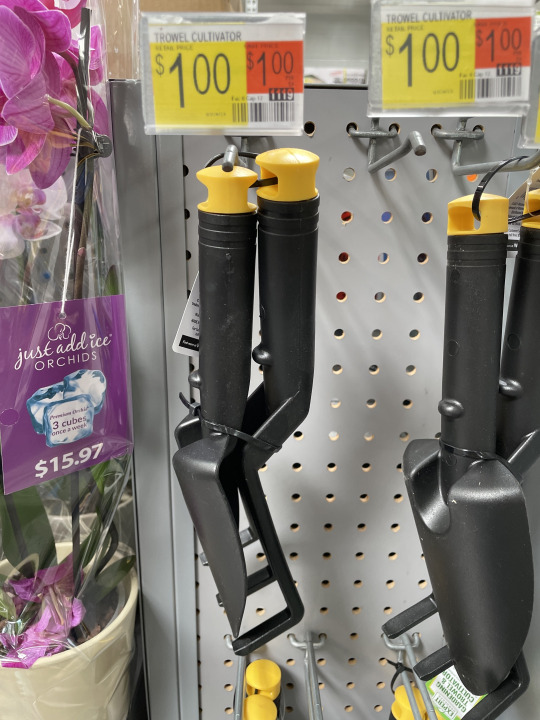
Spotted in a Walmart gardening section by the registers, 2023.
Of course, your mileage may vary with these. I genuinely cannot think of the last time my house got a newspaper, and as I've mentioned I don't have to worry about snow. Similarly, maybe you don't use plastic cups when you can help it, or don't have a particular affinity for eggs and yogurt. Maybe there isn't a tool library in your area--I sure don't know if there is in mine--but it could still be worth poking around and asking a neighbor!
That's the end of this post! My next post is gonna be about ways to support your plants for cheap--we're gonna be talking compost, mulch, and trellises. Until then, I hope this advice was helpful! Feel free to reply with any questions, your success stories, or anything you think I may have forgotten to add in!
#biodiversity#solarpunk#gardening#outdoor gardening#growing from seed#budget gardening#cheap gardening#indoor gardening#ani rambles#out of queue#the biodiversity saga#I can make a post later about how I prepare solo cups for being used as pots if yall want#I've found its safest to just use a nice pair of scissors and keep the cup upside-down on the table while I cut into the bottom#and when i say 'take care of the tools when not in use' i mean 'dont be me and leave a cheap shovel from dollar tree out in the rain'#it had a wooden handle and it basically just like. rotted. fell apart in my hand when I picked it up#generally keeping tools in the garage will also help them not rust as fast too#but if you're gonna leave them outside at least put them in shade#the number of times i have lost feeling in my hands because i picked up a hoe that was laying in the sun and fuckin SCALED my palms#its not fun. dont do it. maybe its a Floridian problem but still#if you read all these tags. uh. shovel emoji. idk. sorry dude.
221 notes
·
View notes
Text
Actionable things to do, from a white childless non-usa womanoid:
- Think global act local
- Act woman-owned, woc/poc-owned, queer-owned, indigenous-owned as much as possible. Research which companies' parent companies should not be given money.
-uplift women of colour, and lgbtqia+ and femme people whenever you can, know when your voice should be the loudest but give others who sorely need a voice have not just their turn but their respect too. Let them know openly and politely when they have earned some of your admiration, and stand up for them in social situations, if it is safe to do so. Find safe people, we have strength in numbers too. Ask around at libraries and youth group and elder activity halls if theres a space theyd be willing to help you set up a community garden in
- Decenter men, decenter money, focus on community and kindness.
* adhere to the 4b movement and/or other woman+kindness-focused ideals that appeal to you with as much longterm conviction as you can find. We have been strong for so long and we can continue to be until we do not Need to be Strong anymore. We can, and will, get this right and make the world tender again. But we have to be strong enough for now to recognize our issues are each-others and we need to start with building a community where we are and building it out globally from there. We need to be amplifying the voices of the most truly deeply hurt peoples within our local communities and assisting those people the most, to build companionship and community and creativity and kindness and compassion into our joint futures. We need to not continue to isolate groups of people down further and encourage fear and distrust, this is what They want. Redirect people who are trying into genuine ways to help, instead of berating or complaining. Our issues might not be the same but they stem from the same roots of misogynistic bullshit and it's more important now maybe than ever to stand united and start fixing things locally first from a place of understanding, not separation.
- Find local shelters or soup kitchens or nonprofit places that primarily help women and/or poc and/or queer people, or facilities that supply safe sexual and reproductive health services for people with utersus, and volunteer in whichever way you can. Things that help often include serving food, preparing food that can be served or heated easily, donating cans or nonperishables. You can also donate blankets and clothes directly to the folk using the shelters if you're unsure of the people ‘running’ the place. Handmade items (knitting, crochet, quilting, sewing, etc.) might be a creative outlet for any frustrations felt too, keep in mind as many body-types that might make use of your item as possible. Some facilities might accept donations in the form of cleaning, or hosting their community bake-sales, or admin, or various other tasks so ask what kind of help they might need that would suit your personal skillset and limitations.
- Acquire books on edible gardening, on human anatomy and medical knowledge, -including mental health knowledge,- on cooking especially with cheap and shelf-stable ingredients. Find books on camping, survivalist tips, and general DIY tips for furniture and clothing and home-maintenance. Plumbing, witchcraft, electricity, tiling, any other book of practical skills could be useful too. Books written by (woc)women and queer people should be your first choice but take what you can get. Thrift stores often have cheap books (or are sometimes willing to give some away if you’re kind enough) but of course this does depend on where you live so acquire books in whichever way is most accessible to you. You can screenshot/save any information you find on the internet too, but it might be a good idea to print or write it out as well, and be sure to get information from smart, women, of colour, who know what they're talking about.
- if youre able, purchase as many contraceptive options and menstrual products as you can. Do not advertise that you have these, give them out to trusted women in need when needed. Do not hoard them, allow other menstruators to purchase them too but do look up the shelf-life of each product. Ive heard that a planB has a shelf life of four years, so thats possibly worth stocking up on, if you have the space and finances and support from within your home. I've not confirmed this though so please take this information with a grain of salt.
- get familiar with your body, aquire sex and selfpleasure toys, learn to use the tools you have safely to reach orgasm or whatever sexual satisfaction means to you. Be honest with yourself about your needs and limits. Post-nut clarity shouldn't be pushed to the backburner for women and femmes and it should be attained without the help of a man whenever possible. Emotional regulation will be hard but this is one of the best ways to stay focused and keep your body and mind from acting out out of a place of loneliness and self-hate. Dance, sing, scream, orgasm, create, do it all as primally as your vessel can handle to regulate, to activate social, empathy, and love and happiness centers of your brain and body.
- Don’t use period trackers or fertility trackers or any such websites/applications. Keep yourself safe online, use usernames and pseudonyms and nicknames that aren't identifiable back to your real life. Keep details of your real life limited to trusted people in trusted circles. Keep community in mind but use discretion as to who’s truly a trustworthy person to tell your thoughts or experiences to.
- Australians call and write and email your states leaders, everybody do this actually but Aus is rapidly approaching its own crisis-scenario so make your voice heard, make your wishes clear, keep your intentions away from discussion with political heads but remain focused and concise with the outcome of upcoming potential bills and laws that you want to see. Make it clear and factual what you don't want to see too, without making it into personal threats or insults (despite how much you might want to sling some choice words toward your resident Rich Whiteman). Statistics are your friend here but remain honest with yourselves about where the stat comes from and about how Statistics are often played with for the benefit of the author.
***I’m too stressed to think lately. As I find or think of more tips i’ll add them. Please stay safe ladies. Carry a hammer, any weaponry you feel confident to use. Know that knifework can be dangerous to you if you’re not experienced at it. Know too that you must survive. Out of hope, out of spite, out of rage or love you must survive. We can not lose this battle when we have been fighting it for so long. Do not give up now. Please. Rest when you need but please, do not give up now. <3
#personal#4b movement#punk#idk how to tag this. if women of colour. women and queer folk in general too but mostly woc could gently tell me if ive made a mistake in#my wording or my topic points im really just wanting to give the best workable advice for. everyone but specifically white middleclass wome#as thats my situation so thats what i know im trying to make this whole thing as digestible as possible for people like me that maybe haven#been as fortunate to experience the moral and social ideologies that i have been exposed to#for the people that might answer 'what radicalized you' with 'nothing. yet.'#i just wanna help but i feel so limited with my own physical health and mental wellbeing so i figure this is at least something#i hope its the right kind of something im not trying t start more fights or cause offence so please just be kind in your correction if i di#start looking seriously into gardening. some plants have been said to assist with many medical issues#from healing minor aches and pains to ridding of things that are unwanted#look into that be safe be discressionary be discreet#if you can grow some plants indoors even on a little balcony bench thats always a nice way to let out frustration too and after all.#plants take time to grow their best bloom
4 notes
·
View notes
Text
youtube
A woman shows you all kinds of containers that to and don't work for raising little transplants inside of your home! And she's right and I agree with her.
#starting seeds indoors#youtube video#now gardening#growing food#diy plant containers#i never even dared to try out those degradable ones#i wont even put the seeds in newspapers#it obviously can't degrade soon enough and roots get tangled in it#i feel so validated by her use of plastic food containers#thats how i do it too!#Youtube
83 notes
·
View notes
Text

Everyone pls welcome Juniper, the jalepeno plant
#pls don’t let me kill it#stardew valley irl#gardening#if anyone has tips on how to grow veggies indoors pls let me know
4 notes
·
View notes
Text
A Beginner's Guide to Growing Herbs Indoors: Tips for Thriving Indoor Herb Gardens

For those who have never grown herbs before, cultivating them indoors can be a delightful and fragrant experience. Growing an indoor herb garden is a wonderful and doable hobby, regardless of your interest in cooking or just the convenience of having fresh herbs on hand. This in-depth guide will show you how to successfully grow your very own indoor herb garden..
Choosing the Right Herbs: Start by selecting herbs that are well-suited for indoor cultivation. Popular choices include basil, mint, rosemary, thyme, and parsley. Choose herbs that share similar growing requirements to simplify maintenance.
Selecting the Right Containers: Choosing the right containers is crucial for successful indoor herb gardening. Ensure that your pots have adequate drainage holes to prevent waterlogging. Additionally, consider the size of the pots, allowing ample space for root growth.
The Perfect Potting Mix: Herbs thrive in well-draining soil. Create a suitable potting mix by combining regular potting soil with perlite or coarse sand to enhance drainage. This ensures that your herbs receive the right balance of water and air.
Providing Adequate Light: Indoor herbs require plenty of sunlight to thrive. Place your herb garden near a south-facing window where they can receive at least 6-8 hours of sunlight daily. If natural light is scarce, consider supplementing with fluorescent grow lights.
Watering Wisely: Overwatering is a common mistake in herb gardening. Allow the topsoil to dry out slightly before watering. When watering, do so thoroughly, ensuring the water reaches the roots. Always use a saucer under the pots to catch excess water and prevent water damage.
Temperature and Humidity: Most herbs prefer temperatures between 60-70°F (15-21°C). Ensure the indoor environment remains well-ventilated, as stagnant air can lead to problems like mold. Humidity levels between 40-60% are generally suitable for herb cultivation.
Fertilizing Routine: Herbs benefit from periodic feeding during the growing season. Use a balanced, water-soluble fertilizer every 4-6 weeks. Be cautious not to over-fertilize, as this can harm the plants.
Pruning and Harvesting: Regular pruning encourages bushier growth and prevents herbs from becoming leggy, or similarly, elongated or stretched. Harvest leaves in the morning when the essential oils are most concentrated. Avoid removing more than one-third of the plant at a time to ensure continued growth.
Dealing with Common Pests: Keep an eye out for common pests like aphids and spider mites. A mild solution of water and dish soap can help control these pests. Alternatively, introduce beneficial insects like ladybugs to keep your indoor garden pest-free.
In closing, embarking on the journey of growing herbs indoors is a delightful adventure for beginners. By choosing the right herbs, containers, soil, and providing the optimal growing conditions, you'll soon be enjoying the bountiful harvest of your indoor herb garden. Follow these tips, stay patient, and watch as your herbs flourish, bringing a touch of freshness to your culinary endeavors. Happy herb gardening!
#botany#garden#gardening#horticulture#how to#life hacks#planting#plants#tips and tricks#Indoor Herb Garden#Culinary Herbs#growing herbs#home gardening#container gardening#gardening tips#seeds#vegetable gardening#urban gardening#Beginner Gardening#organic herbs#Sustainable Gardening#Kitchen Herb Garden#Herb Planting#herbalism#Herb Care#Gardening Tips#indoor plants#house plants#potted plants#DIY Herb Garden
2 notes
·
View notes
Text
i need 2 start prepping for the hobbies i want 2 start
#like picking out articles of clothing i wanna try to sew figuring out what i want to plant collecting recipes i want 2 try....#the issue with planting at least is idk where ill be living ik the gardening zone but like. idk if ill have a garden ykwim. and i think im#gonna Start with indoor plants like herbs etc. and then also have flowerpots and maybe plant a strawberry bush Or something of the sort..#n i also wanna plant pumpkins bc my family has started growing pumpkins and my brother was so excited 2 tell me abt jt#they only got 1 this year and it was Itty bitty but he was so excited. so i think hell rly love it if i grow pumpkins too...#he probably wont actually get 2 See the pumpkin in person unless we do a pumpkin exchange me and my mom talked abt that#where both of us grow pumpkins and then we trade... but idk how 2 ship pumpkins Lmao
1 note
·
View note
Text
Hydroponics: The Complete Guide For Beginners to Learn How to Start Gardening Indoor and Growing Fresh Vegetables, Organic Fruits and Herbs at Home With the Revolutionary Hydroponic Garden System.
Hydroponics: The Complete Guide For Beginners to Learn How to Start Gardening Indoor and Growing Fresh Vegetables, Organic Fruits and Herbs at Home With the Revolutionary Hydroponic Garden System.
Hydroponics: The Complete Guide For Beginners to Learn How to Start Gardening Indoor and Growing Fresh Vegetables, Organic Fruits and Herbs at Home With the Revolutionary Hydroponic Garden System. Product Description & Features: Locale : en_US Name : Garden Liam Role : Author Kindle EditionDigital Ebook Purchas *** Estimated Price: $2.99 Shop now at Amazon.com – CLICK HERE for more product…
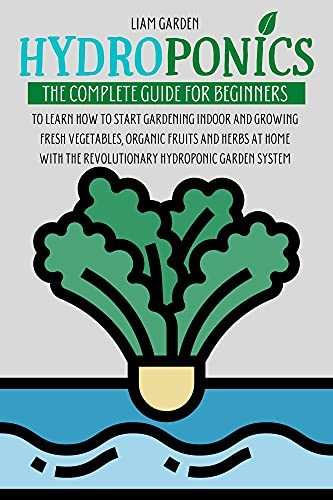
View On WordPress
#AeroGarden#and#at#Beginners#Complete#for#Fresh#Fruits#Garden#Gardening#Growing#Guide#Herbs#Home#How#Hydroponic#Hydroponics#Hydroponics Growing System#Hydroponics Growing Systems#Indoor#Learn#Organic#Revolutionary#Start#System#the#to#Vegetables#with
3 notes
·
View notes
Photo

(via Houseplant How-To)
#houseplant how to#diy houseplant#bugs houseplants#containers#diseases of houseplants#gardening#indoor garden#how to grow houseplants#how to propagate plants#how to repot plants#how to water plants#indoor plants#leaf cuttings#plant lighting#repotting plants#stem cuttings plants#watering houseplants
0 notes
Text
youtube
Yesterday the weather outdoors was super terrible, so my Solarpunk Action was setting up a little gardening station in the corner of my laundry room so I could get tomato seedlings started.
#solarpunk#Solarpunk Presents Podcast#podcast#podcasting#solarpunk action week#SPAW#tomatoes#seedlings#grow light#how to start tomato seedlings#starting tomatoes from seed#starting tomatoes from seed indoors#gardening#gardening in canada#indoor seed starting#Solarpunk Action Week#Youtube
0 notes
Text

Embarking on apartment gardening as a beginner can be both exciting and rewarding. With the right tips and ideas, you can transform your living space into a thriving green haven. Opt for indoor plants that thrive in low-light conditions and are easy to care for. Some excellent choices for beginners include pothos, snake plants, spider plants, and peace lilies. Research the specific needs of each plant to ensure they're suitable for your apartment environment.
#Apartment Gardening Made Easy: Tips and Ideas for Beginners#Apartment Gardening: Step-by-Step Guide for Beginners#Beginners Guide to Apartment Gardening Tips#Apartment Gardening for Beginners -Tips and Tricks#Gardening ideas and tips for beginners#gardening ideas for beginners at home#How to start a garden at home?#How can I design my own home garden?#Which plant grow fast at home?#What are the best ways to do indoor gardening as a beginner?#Real Estate#Bricksnwall
0 notes
Text
Lettuce update



This is what succession sowing looks like. The first picture shows seeds sprouting at about a week old. These have been sown in peat pucks (which is not environmentally friendly and I don't recommend that. I use them because I got them as a gift), the others are two weeks old and in my own soil mix, and the bottom picture are three weeks old now and starting to form hearts. Succession sowing just means sowing every few days or every week so you can get a succession of crops that ripen at different times. This way you avoid a glut (and can get a little gardening in while the weather stinks!)
#how to garden#indoor garden#garden witch rambles#home--farm#succession sowing#growing vegetables#grow your own
0 notes
Text
How to Care for Poinsettias? All You Need To Know
How to Care for Poinsettias? Welcome to our How-To Guide on caring for Poinsettia plants, the perfect addition to your home’s festive decor. As the holiday season approaches, Poinsettias bring vibrant colors and elegance. This guide will walk you through essential steps to ensure your Poinsettias not only flourish during the holidays but thrive year-round. For a visual walkthrough, check out the…

View On WordPress
#christmas plant#christmas plant care#christmas plants indoor#christmas poinsettia#euphorbia plant#euphorbia pulcherrima#euphorbia pulcherrima care#euphorbia pulcherrima plant#gardening tips#gardening tips for beginners#house plant#houseplants 101#How to Care for Poinsettias#how to grow poinsettia#how to make christmas poinsettia#poinsettia care#poinsettia care guide#poinsettia care tips#poinsettia plant care#poinsettia plant care in winter
0 notes
Video
youtube
Eco-Friendly Gardening: Sprouted Popcorn in Toilet Paper Rolls 🌽
🌷💚 Transform your indoor space with our unique gardening project! 🌿 Learn how to plant sprouted popcorn in lean toilet paper rolls for a sustainable and fun garden experience. 🌽🧻 Our video tutorial provides clear and easy-to-follow instructions, ensuring your success from start to finish. 🌞 Discover the benefits of using high-quality seed starting soil and the best care practices for your new plants. 🌿 This project is perfect for all ages and skill levels, making it a great family activity. 🌻 Enjoy the satisfaction of growing your own popcorn plants and contribute to a greener planet. 🌍 Subscribe for more innovative gardening ideas and join our community of eco-conscious gardeners! 🌱
#youtube#youtube video#youtube views#video#videos#popcorn#howto#how to video#grow#growing vegetables#vegetable garden#vegetable gardening#vegetables#grow your own#ecofriendly#ecofriendlygardening#indoors#gardening ideas#gardening#gardening tips#gardening hacks#gardenblr#gardencore#gardeningproject#tip#tips
4 notes
·
View notes
Text
How to Grow Ficus 'Audrey' and Ficus ficus benghalensis
The Banyan Tree, scientifically known as Ficus benghalensis (and sometimes sold as Ficus ‘Audrey’), is a magnificent and iconic tree known for its aerial roots and grandeur. While commonly found outdoors in tropical regions, it is also possible to grow this impressive tree indoors, bringing a touch of nature’s splendor into your living space. In this article, we embark on a journey to uncover…
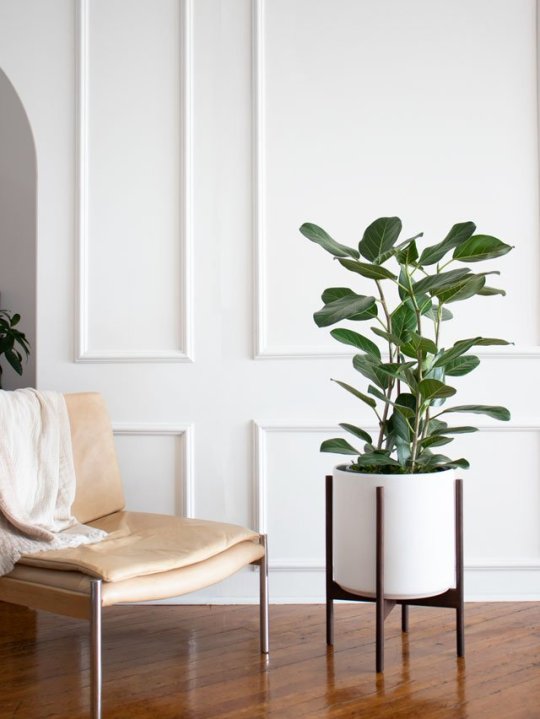
View On WordPress
#bright light houseplants#ficus#growing houseplants#How to Grow Ficus &039;Audrey&039; Ficus ficus benghalensis#indoor gardening#tall houseplants
0 notes
Text
With our selection of beautiful and stylish pots, you can bring a touch of elegance to your garden.
📞 +91 9188006567
🌐 greenberrygarden.com
📍Nellankara, East Fort
Thrissur, Kerala
Pincode - 680005
WhatsApp: https://wa.me/9188006567
Facebook: https://www.facebook.com/profile.php?id=100088505012110&mibextid=LQQJ4d
YouTube: https://youtube.com/@greenberrylandscaping4573
Location map: https://maps.app.goo.gl/Fo2H72TkmREnZFT56
#pottery #ceramics #handmade #clay #art #ceramic #ceramicart #ceramica #stoneware #homedecor #design #potterylove #keramik #instapottery #pottersofinstagram #wheelthrown #handmadepottery #handmadeceramics #potterystudio #tableware #porcelain #contemporaryceramics #interiordesign #artist #potterylife #potter #glaze #craft #clayart #ceramique

#indoors#house plant#landscape#pot#plant#indoor pots and planters#indoor garden#ceramicspotteryclay pots ceramic porcelain ceramica ceramicart potter clayarthandmadeceramics ceramique contemporaryceramics#fibreware#homedecor#indoor plants#monstera adansonii#monstera peru#monsteramonday#how fast do monstera grow#decor#ceramicdesign#cute ceramics
0 notes